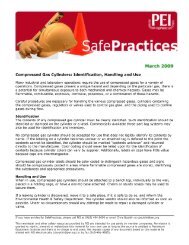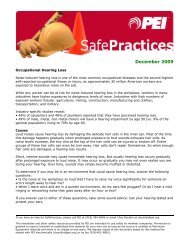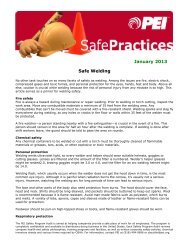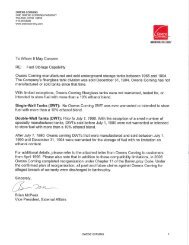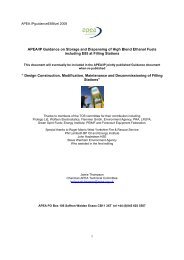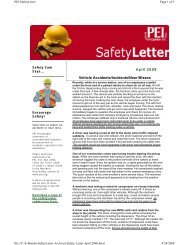You also want an ePaper? Increase the reach of your titles
YUMPU automatically turns print PDFs into web optimized ePapers that Google loves.
July 2005<strong>Safe</strong> <strong>Practices</strong>Cell Phones and DrivingIn the United States some 190 million people used cell phones as of June 2005, compared withapproximately 4.3 million in 1990, according to the Cellular Telecommunications & Internet Association.Increased reliance on cell phones has led to a rise in the number of people who use the devices whiledriving. There are two dangers associated with driving and cell phone use. First, drivers must take theireyes off the road while dialing. Second, people can become so absorbed in their conversations that theirability to concentrate on the act of driving is severely impaired, jeopardizing the safety of vehicleoccupants and pedestrians. Since the first law was passed in New York in2001 banning hand-held cell phone use while driving, safety experts havebegun to focus on the problem as part of the larger one of driver distractionsin general, which can include anything that reduces driver concentration onroad hazards from drinking coffee to talking with another passenger. Inaddition, they acknowledge that the hazard posed by cell phoneconversations is not eliminated, and may even be increased, by the use ofhands-free sets.RECENT DEVELOPMENTS• Businesses: Businesses are increasingly prohibiting workers from using cell phones while drivingto conduct business. In July 2004, the California Association of Employers recommended thatemployers develop a cell phone policy that requires employees to pull off the road beforeconducting business by cell phone.• Court Decisions: In December 2004 a civil case involving a car crash caused by a driver using acell phone for business reasons was dismissed when the driver’s employer agreed to pay theplaintiff $5 million. The plaintiff in the case was severely injured in the crash. The suit is among themost recent of several cases where an employer has been held liable for an accident caused by adriver using a cell phone.• In mid-October 2004 a jury awarded $2 million in damages to the family of a young girl who waskilled by a driver using a cell phone at the time of the accident. The plaintiff also filed a suit againstthe driver’s employer after it became clear through an examination of phone records that the driverhad been talking to a client when she hit the girl.• State and Federal Initiatives: The number of state legislatures debating measures that addressthe problem of cell-phone use while driving and other driver distractions continues to rise.According to the National Conference of State Legislatures, over two-thirds of states looked at billsthat would restrict the use of cell phones while driving in the first part of 2005. Four states —Colorado, Delaware, Maryland and Tennessee — banned their use by young drivers in 2005. InMay, the city of Chicago banned the use of hand-held cell phones while driving, imposing penaltiesof $50 or $200 (the latter if the driver is involved in an accident).• In June 2005 the Connecticut legislature passed a bill banning the use of hand-held cell phoneswhile driving. The governor is expected to sign the legislation, which imposes fines of up to $100for violations. In January 2004 New Jersey passed a similar to bill and in April of that year theDistrict of Columbia (DC) followed suit. In New Jersey fines range between $100 and $250; in DCfines are $100. New York was the first state to enact such legislation in 2001. Drivers there facefines of $100 for the first violation, $200 for the second and $500 thereafter.• In June 2003 federal and state highway safety agencies issued new guidelines for reportingcrashes caused by distracted drivers. The authorities are asking police across the nation to notewhether a driver was distracted and the source of the distraction, such as cell phone, radio,passenger, or another vehicle.



